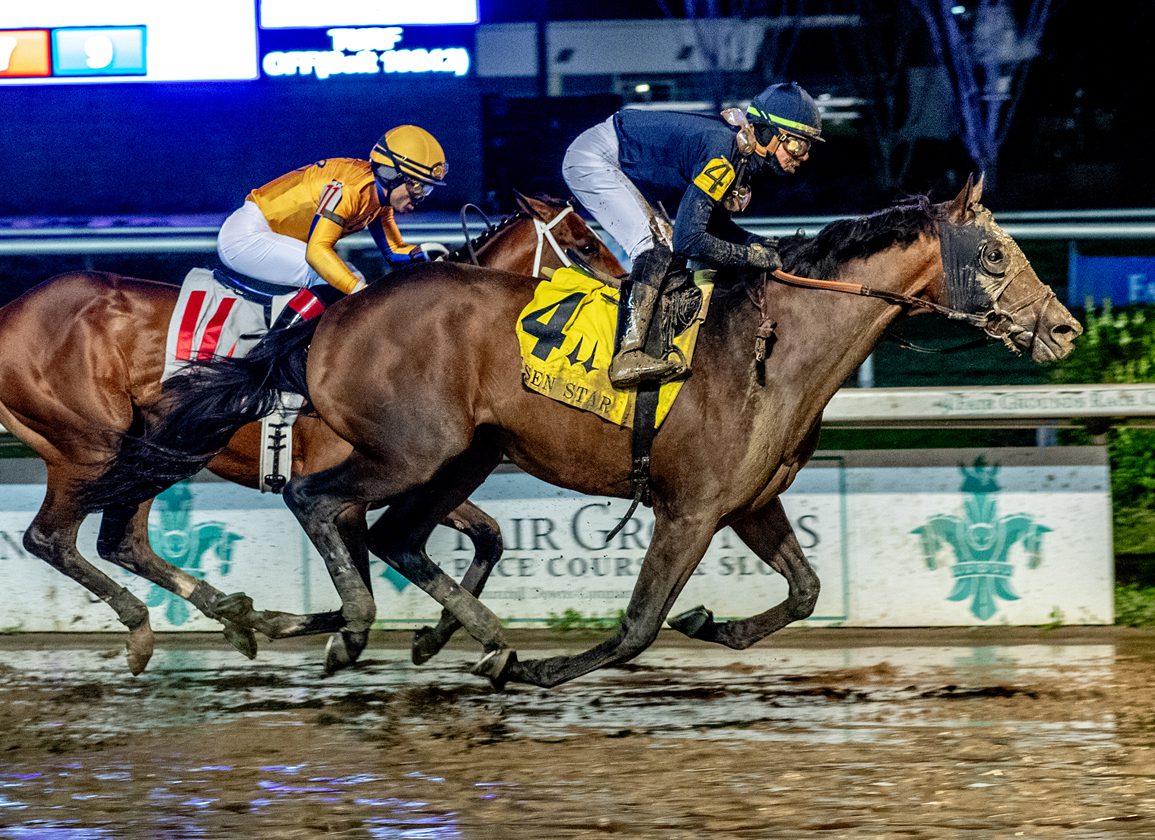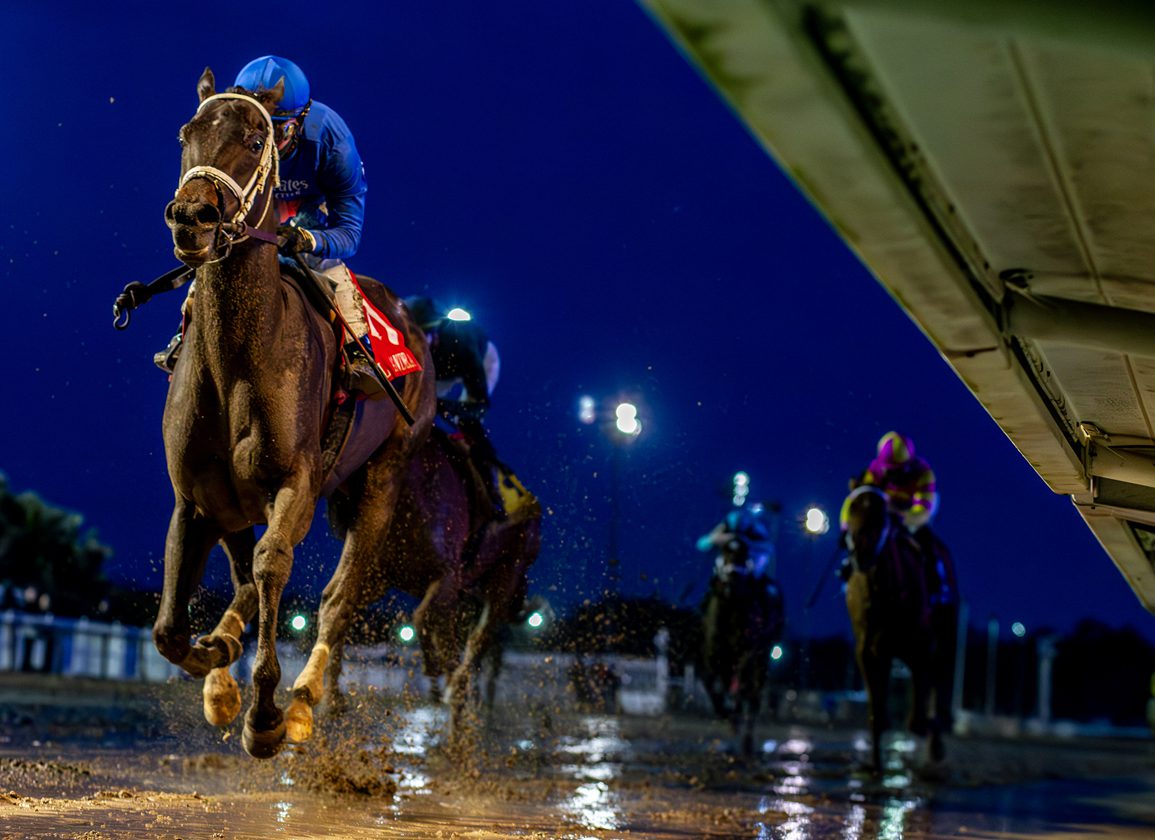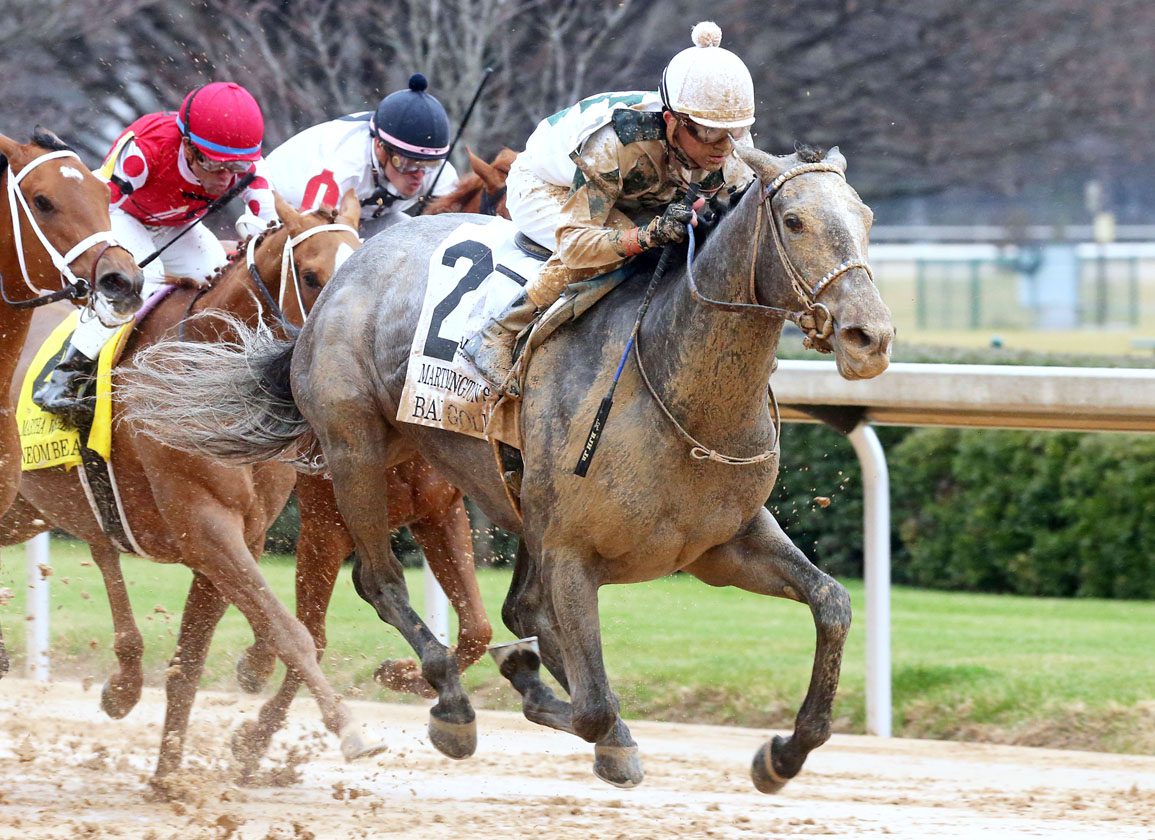By Chris McGrath
Among the winners at the last Breeders' Cup, what was it that separated White Abarrio (Race Day), Goodnight Olive (Ghostzapper) and Nobals (Noble Mission {GB}) from the rest? Answer: they were the only ones that had changed hands at an American yearling auction, respectively for $7,500, $170,000 and $3,500.
Even that lavish investor in the yearling market, Mike Repole, won the GI Breeders' Cup Juvenile with a homebred. Except for a couple of European turf juveniles, the rest of the show was a parade of champions raised by “end users”: a couple apiece for Godolphin and Juddmonte, plus one each for the programs operated by Coolmore, Cheveley Park Stud and George Krikorian.
Now, to be fair, they all reached that coveted winner's enclosure with the help of stallions beyond most pockets, with Curlin the most radiant example. And, besides, we're obviously peering through a narrow and fairly random window on the overall state of the game.
That said, if this meeting is where we all want to end up, it would be very hard to look at this sample and conclude that the commercial market is functioning very effectively.
That won't bother most people, so long as they can keep eking out some kind of profit from a fiendishly precarious trade. But perhaps it's a useful context to remind ourselves of the fundamental equilibrium on which the whole market depends: namely, that you need to retain sufficient mystery for the little guy still to have a chance; but values meanwhile have to stand up enough for the big investors to feel as though they can get some kind of edge. Put it another way: if the sale-topper won the Derby every year, the whole business would collapse overnight; but if a Rich Strike won every year, well, the whole business would collapse overnight.
Anyway, the point is that every now and then the industry needs a 'TDN Rising Star' Sierra Leone (Gun Runner) to come along and make sense of what, in his case, was the second highest price paid at an American yearling auction in 2022.
His first three dams are, respectively, a juvenile Grade I winner, a dual Grade I runner-up (also at two) and a Grade I sprint winner; and, as luck should have it, he belongs to the third crop of what has meanwhile proved the most phenomenal young sire of recent times. When you spend $2.3 million on a colt that has never had a saddle on his back, you're obviously wagering primarily on a potential stallion career. And, with those Twin Spires taking tangible shape on the horizon, the partners who placed this particular bet are still very much in the game.
Sierra Leone was bred by Debby M. Oxley from her homebred GI Darley Alcibiades S. winner Heavenly Love (Malibu Moon), whose dam Darling My Darling (Deputy Minister) had been bought by Oxley's husband John for $300,000 as a Keeneland September yearling in 1998.
Darling My Darling's own mother, GI Ballerina H. winner Roamin Rachel (Mining), was sold in the same ring that November, to Nobuo Tsunoda for $750,000–a price vindicated the following summer when Darling My Darling (her second foal) won on debut at Saratoga before consecutive runner-up finishes at Grade I level.
Roamin Rachel had been sold carrying a Storm Cat filly, who managed a single start, but has since produced three group winners in Japan; Roamin Rachel, for her part, was sent for her next cover to Sunday Silence, and came up with Japanese Horse of the Year Zenno Rob Roy (Jpn).
Heavenly Love's half-sister by Congrats, herself Grade II-placed, has meanwhile given the family tree additional Japanese luster through her son Forever Young (Jpn) (Real Steel {Jpn}), who is about to try to give the family a second consecutive weekend in the sophomore spotlight in the G3 Saudi Derby.
Even without that later boon to his page, then, everything was in place for Sierra Leone on paper. Heavenly Love herself admittedly proved unable to build on her juvenile success, albeit she did manage third in the GIII Regret S.; while her first foal by Uncle Mo did little more than retrieve the covering fee. Sierra Leone must have been a very different physical proposition, then, to be topping the Fasig-Tipton Saratoga Sale.
It had been prescient of his breeders, of course, to persevere with Gun Runner at precisely the point most commercial breeders back off from exposure by a stallion's first runners on the track. The Three Chimneys top gun would take the customary trim in fee the following year, from his opening $70,000 to $50,000, but his numbers held up throughout: 156 mares kept the faith in 2020, leaving Sierra Leone among 120 live foals in his third crop. These also include the fillies who consolidated another stellar weekend for their sire by finishing second and third in the GII Rachel Alexandra S. and first and second in the Sunland Park Oaks.
We have long since got over any surprise that Gun Runner's first crop should have been so precocious, making him not just champion freshman but leading sire of 2-year-olds, despite himself having thrived with maturity. As a result, however, fewer people remarked how his second crop actually made precisely the kind of tepid start that might have been readily indulged in their predecessors. In fact, as juveniles they didn't muster a single stakes success between them. Four, however, proceeded to win graded stakes as sophomores last year.
Gun Runner's third crop tilted the balance back the other way. Of 45 entering the gate as juveniles last year, four won graded stakes–including Locked, already his seventh Grade I winner and himself about to resume the Derby trail.
Sierra Leone missed becoming the crop's fifth juvenile graded winner by just a nose, in the GII Remsen S., but has now emulated his sire by winning the GII Risen Star S. off a layoff. Whether his focus was aided by blinkers, or he's simply becoming more professional with experience, he saw the race out rather better than when worried out of the Remsen, despite that wide sweep for home and runner-up Track Phantom (Quality Road) having controlled the tempo at his leisure.
Track Phantom had cost $500,000 at Keeneland September, where the third Catching Freedom (Constitution) was similarly found in Book 1, for $575,000. Given that Catching Freedom looked like a horse still learning his trade, this proved a race to give fresh credibility to the yearling market. Perhaps we don't have to tear up those catalogues just yet.
'Beach'-Combers Share Godolphin Success
As already acknowledged, breed-to-race programs are only so dominant because they tend to match their patience–such a rare commodity in the commercial sector–with similarly uncommon financial resources. But they still need discipline, and the fatalism to accept that the culls essential even to the most lavish operations will occasionally convert years of work and expense into an overnight dividend for somebody else.
The Godolphin team's delight over the success of 'TDN Rising Star' Tarifa (Bernardini) in the GII Rachel Alexandra S. is presumably tempered somewhat by the fact that they sold her young dam Kite Beach (Awesome Again), carrying a full sister, just nine months after she had delivered this first foal. Mind you, a good deal more regret is doubtless being experienced by the people who bought Kite Beach at the Keeneland November Sale for $100,000, because just weeks later they “flipped” her for $115,000 at Fasig-Tipton February. That must feel like a pretty marginal gain now.
Ultimately Kite Beach was bought by Calumet, who sold Tarifa's sister at Fasig-Tipton last July for $105,000. While that sale nearly cleared their investment in one hit, congratulations must in turn go to purchaser Matthew Davis. Both he and Calumet, with their different stakes in her success, must be watching Tarifa's rise with due excitement.
Because for Kite Beach to produce a talent like this, at the first attempt, revives a rather dormant branch of an extremely famous family tree. She's a daughter of Tizdubai (Cee's Tizzy)–whose own mother Cee's Song (Seattle Song) must be counted one of the most remarkable producers of modern times.
Tizdubai was bought for Sheikh Mohammed as a weanling by John Ferguson for $950,000 at the 2001 Keeneland November Sale, a price that reflected her brother Tiznow's second consecutive success in the GI Breeders' Cup Classic just days previously. Cee's Song and Cee's Tizzy had already produced his brother Budroyale to finish second in that race, besides winning multiple graded stakes; and Tizdubai herself would duly proceed to win the GII Sorrento S.
Cee's Song was herself sold at the same November Sale as Tizdubai, for $2.6 million, inevitably in foal to Cee's Tizzy. The resulting filly, Tizamazing, never made the track but later produced Classic winner Oxbow. Unfortunately, the new owners of Cee's Song evidently decided that she was doing all this despite Cee's Tizzy, and not because of him, and instead favored her with serial $500,000 dates with Storm Cat.
These did not work out so well. Meanwhile another of the Song–Tizzy crew, Tizso, was sold for $625,000 despite an unproductive track career, and then produced Paynter to win the GI Haskell S. (Tizso also produced a couple of seven-figure yearlings so it was disappointing, shall we say, to see her sent into the ring at the age of 25 and sold for $62,000).
Both Paynter and Oxbow were by Awesome Again, and it was resorting to that ageing patriarch for Tizdubai's 2016 cover that produced Kite Beach. By then Tizdubai had come to seem a disappointing producer, despite serial elite covers.
Kite Beach did nothing to improve matters, being unraced, while her siblings that did make it to the racetrack showed little. One Shamardal filly did win on debut in England, but ended up struggling in a low grade and was sold for 45,000gns. Her son by Pioneerof the Nile is Cabo Spirit, latterly a dual graded stakes winner on turf in California, but Tizdubai's overall record as a producer makes it easy to understand why Kite Beach should have been culled.
But Awesome Again has served the Deputy Minister brand very well, as a broodmare sire; and of course Tarifa is by an outstanding such influence in Bernardini. So you'd have to be optimistic for Tarifa's prospects in her next career, as Mr. Davis can be about her sister.
Remarkable to see, meanwhile, that Calumet's first choice for Kite Beach was Paynter's son Knicks Go. The resulting colt, now a yearling, is inbred to an exceptional degree: his dam is by Awesome Again out of Tizdubai, and his grandsire is by Awesome Again out of Tizdubai's full sister Tizso. Plenty of egg in that pudding!
Patience Pays On Both Sides For Stronghold
As just noted, Awesome Again has contributed to a cluster of successful broodmare sires under Deputy Minister (himself sire of Sierra Leone's second dam). And among others to do so is his own son Ghostzapper, most conspicuously as damsire of Justify.
We have also credited Ghostzapper as one of those few sires to get a commercial yearling into the winner's circle at the last Breeders' Cup. So his prowess as a distaff influence must now augur well for the lady in question, Goodnight Olive, in her maiden cover by Not This Time (who sired Up to the Mark from a Ghostzapper mare).
Ghostzapper has now turned 24 but continues to rebuke the (largely self-fulfilling) mistrust among some breeders regarding older sires. Over the years he has also paid for a lack of precocity in his stock but nonetheless accounted for perhaps the most brilliant juvenile of last summer in Rhyme Schemes, unfortunately sidelined since.
Last weekend another member of the same crop, Stronghold, won the GIII Sunland Derby, the 100th worldwide stakes winner for Ghostzapper. Either way, how well he has steadied the ship after enduring some wild tides early in his stud career. Launched at $200,000 after one of the definitive speed-carrying displays of the modern breed, Ghostzapper was slashed from $125,000 to $30,000 (and soon $20,000) in one go after his first juveniles blew out. It was a long road back, but he fully merits a fee that has settled at $75,000, with career ratios that make him a very similar sire to Uncle Mo.
Stronghold himself is another of those homebreds to advertise the merit of playing the long game. Eric and Sharon Waller bought his fourth dam after she was a $12,000 RNA at Barretts in January 1998, and from her bred Swiss Diva (Swiss Yodeler) to win her first three starts including the California Breeders' Champion S. by eight lengths. Swiss Diva's first foal (a filly by Henny Hughes) was unable to race because of injury, but she would redress that misfortune as dam of Spectator (Jimmy Creed), winner of the GII Sorrento S. and twice Grade I-placed.
Spectator has now given the Wallers a run at the Derby with Stronghold, who managed to elude Bob Baffert in New Mexico and so elevated himself to fourth in the points board. He had previously counted the Risen Star runner-up and fourth among his pursuers when breaking his maiden over the Churchill surface.
Little Legacy Is On The Money
Marvin “Junior” Little was a man I would have loved to interview. He evidently knew plenty about the “real” world–never finished school, served in the Navy and was set for a factory job until a steel strike intervened–but proved a special talent when finding his way into our magical little one. Eventually he worked his way up to become manager of Newstead Farm, Virginia, until presiding over its $47-million dispersal in 1985. This was crowned by the homebred star Miss Oceana, in foal to Northern Dancer, at what was then a record price of $7 million.
Moving back to his native Kentucky, Little showed no less flair in managing his own, rather more modest program, which notably produced champion Hansel. And while he was sadly lost in 2017, his legacy of horsemanship endures through his children Marilyn, Jeff and Teresa. For they are listed as co-breeders with William Lynn of Money Supply (Practical Joke), who continued his transformation for Joe Sharp in the GIII Mineshaft S.
This horse achieved a good yield as a yearling, selling to Klaravich Stable for $400,000, but last summer he had reached a point where Chad Brown dropped him into a $32,000 claimer at Saratoga. For his new barn, Money Supply is now on a streak of five, reaching a new peak in a race that has lately drawn attention to others thriving with maturity in Olympiad and Maxfield.
As his original cost indicates, Money Supply was bred for this kind of caliber–even though co-breeder Lynn signed a docket of just $30,000 for his dam Evita's Sister (Candy Ride {Arg}) (in foal to the young Into Mischief) at the Keeneland November Sale of 2013. She owed her name to full-sister Evita Argentina, who had won the GI La Brea S., while their dam was out of an unraced half-sister to Trippi.
A few seams of gold there, then, for Practical Joke to be mining. Albeit aided by conspicuous volume, the Ashford sire is clinging to the slipstream of Gun Runner more tenaciously than the rest of their intake, earning a further hike to $65,000 this year. Money Supply is already his fourth stakes winner of the year, and watch out for another of them, the flying Skelly, in the desert this weekend.
A $5,000 Sire Showing Elite Potential
Having long recommended the horse, I make no apology for highlighting the fact that something really does seem to be afoot with Preservationist. Last weekend the Fair Grounds maiden winner Antiquarian, incidentally a $250,000 yearling off a $10,000 cover, became his ninth scorer since the turn of the year. Among second-crop sires, only Audible (12) has more–and they have respectively had 52 and 28 starters.
Preservationist had the commercial odds stacked against him, as a son of Arch who had won his Grade I at the age of six, but he has a sensational shape to his pedigree, posing fourth dam Too Chic opposite his sire's third dam Courtly Dee. Even so, only a farm as enlightened as Airdrie would have given him an opportunity, and his books have been on a predictable slide since he mustered 102 mares for his debut season.
So he had to make his one chance count, and he appears to be doing just that. An interesting template is In a Jam, who took as many as eight starts to break his maiden but posted a big number when doing so and again when following up in allowance company. It looks like people with the patience to let a horse gain a little maturity and experience are going to be very well rewarded, and they can now get to Preservationist for just $5,000.
He even has a filly on the Kentucky Oaks trail, with Martha Washington S. winner Band of Gold heading to the GIII Honeybee S. on Saturday. Her late breeder, Airdrie's founder Brereton C. Jones, was synonymous with that Classic. But he was also celebrated for producing top-class stallions somewhat out of left field–and perhaps we're already seeing that legacy being extremely well-“preserved.”
Not a subscriber? Click here to sign up for the daily PDF or alerts.








